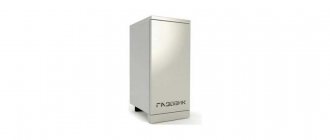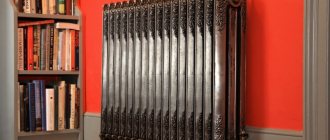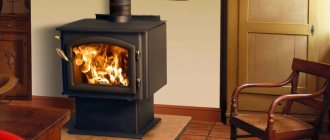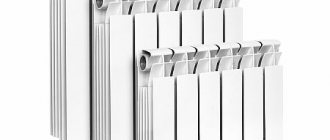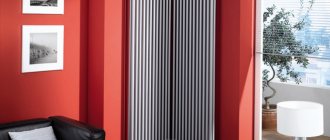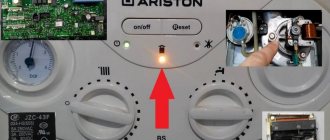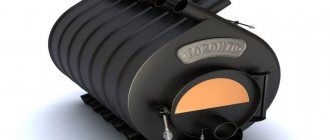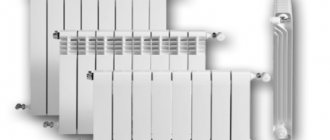A classic cast iron battery does not always fit into the interior. Of course, you can cover it with a beautiful screen or close it with a curtain, but then the lion's share of the heat will simply not reach the room. The solution in this situation can be metal panel heating radiators - they look unusual and have excellent efficiency.
Stylish panel radiator
Features of panel radiators
Steel panel heating radiators are based on modern technologies and are used in various conditions. To increase the efficiency of heat transfer efficiency and expand the coverage of the heated area, steel ribs are installed inside the device. They are distinguished by their U-shape.
This trick increases the heat transfer efficiency by up to 50% additional power. These models are distinguished by the absence of standard sections. Instead, on the front side there is a monolithic panel formed by two sheets of steel with a thickness of about 1.25 mm.
But on the market you can find modifications made of galvanized steel, how do they differ?
- They use thin plates, thanks to metal with a reduced thickness - 0.04 - 0.5 mm.
- The outer part of such models is primed and powder painted.
- The standard color is white, but there are different versions; as a rule, they are made to order in order to harmoniously fit into the interior.
These versions are based on 2 - 3 panels with the addition of decoration on the side and a grille on the top. This allows you to operate a finished interior element with the necessary functionality.
What are the types of infrared heating panels?
All products of this type are divided into two large groups:
- Mounted. Most often they are equipped with a colored metal case, heated by an infrared emitter. The device is powered by a regular outlet. Both separate and mounted types of installation are used.
- Built-in. The basis of such a panel is a plasterboard board covered with a layer of insulation. The IR emitter located on top is made in the form of a carbon conductive wire protected by a polymer sheath. The panel is powered from a standard 220 V network.
As for designer wall heating panels, they can have different colors and sizes, and are usually allocated in a separate line. A slab in the form of a plinth looks very original: it can be used to decorate the perimeter of a heated room. When finishing walls with plasterboard, wall heating can serve as the main one. In those dwellings where the main heating source is already available (solid or liquid fuel boiler), heating panels play a secondary role.
It should also be said about the weaknesses of these devices:
- Although the feeling of warmth from the rays comes almost instantly, infrared devices act mainly locally: one area of the room will be heated, but the other will not.
- Due to the uneven effect of heat on the human body, he may experience health problems - headaches, fatigue, chills.
- Since during operation of the IR panel it is not the air that heats up, but the surrounding objects, a plastic smell may appear in the room due to the heating of plastic surfaces.
- Despite the high power of such heaters (about 1.2 kW), their range of action is usually limited to a space of 8 m2.
- Infrared radiation has a negative effect on the eyes.
Advantages of a panel radiator
The main advantage lies in the affordable price of panel heating radiators, since there are different models and many countries of origin on the market.
Main advantages:
- You can choose a design to harmonize with the style direction of the room. Some manufacturers deliberately unify products with a specific style: modern, classic;
- Comfortable adjustment available. The heating level is easy to control thanks to simplified mechanical or electronic sensors;
- Almost all models provide an excellent level of heat transfer. This is achieved by the special structure of the device and the principle of convection aimed at increasing the efficiency of heat transfer;
- In comparison with analogues, an affordable price is guaranteed, since metal models are created using cheap and reliable steel;
- Helps save energy. A device of this type has a reduced capacity, so heating and starting the heat transfer process requires relatively little electricity;
- It is multifunctional. Any product of this type can be used as a radiator and convector;
- It stands out for its reduced mass. The weight of the structure is insignificant. Therefore, installation is easily carried out by the owner himself.
In addition, the product is usually sold within walking distance. You don't need to spend a lot of time searching for a suitable model.
Manufacturers
Many companies around the world are engaged in the production of infrared heaters.
Below are presented only those of them that really won the hearts of customers with their products.
Stiebel Eltron is a German company that produces equipment of impeccable quality and reliability. Fenix Trading is a Czech company that produces products of the highest quality
Manufacturers pay special attention to the issue of energy efficiency. Air Comfort. Italian manufacturers produce safe, high-quality products. Frico
Swedish manufacturers always place high demands on the design of equipment and guarantee its high quality.
Among domestic manufacturers there are O, "Pion", "Bilyuks" and "Almak", which in their characteristics are practically not inferior to heaters from foreign companies. The Zebra EVO-300 PRO film heater is in great demand. Non-flammable materials are used to manufacture this electric heater, which allows it to be installed in public spaces, as well as in wooden rooms. The Zebra EVO-300 (PLEN) heater is recommended for use in rooms with high humidity.
Disadvantages of a panel radiator
Let's say right away there are not many of them. Perhaps we shouldn’t focus on such minor nuances of operation, but let’s consider these unsightly moments.
Unpleasant aspects of using panel batteries:
- They lack protection against water hammer and are characterized by increased instability. This eliminates the possibility of a secure connection to the central heating option;
- Unfortunately, you cannot go beyond the pH level in the region of 8.3 - 9.5 units, as this may lead to the development of noticeable corrosion. The product is too sensitive to acidic environments;
- The operating instructions indicate that water should not be drained from the system for a long time. But, if you do not perform this procedure at all, then the risk of corrosion increases.
If you do not add liquid for a long time, then corrosion may develop as a result of exposure to oxygen. Therefore, it is necessary to be responsible for the operation and maintenance of a steel radiator.
But, if you follow all the instructions and use the device correctly, then troubles during operation will not appear soon. A high-quality model can last for many years before breakdowns or deterioration in heat transfer levels are detected.
The device of a car interior heater (stove)
The first cars offered their drivers a minimum of comfort - in those distant times, the very ability to move without the help of horses was a novelty, and there was no need to think about comfort
But over time, cars became more advanced, and engineers began to pay attention not only to the technical characteristics of vehicles, but also to the comfort of the driver and passengers. Therefore, at first the cars acquired closed bodies that protected them from bad weather, and later - heating devices that provided comfort when driving in the cold season
It is no longer possible to imagine a modern car without a stove (heater), especially if the car is used in Russia. The presence of a heater has become standard; this feature is offered by default on most cars.
Today, cars and trucks, as well as small buses (PAZ, old LAZ and the like) use heaters that take heat from the engine, and it is these most common heaters that will be discussed further. In city buses with a rear engine, electric heaters are more often used to heat the interior - we won’t talk about them here.
How to choose a panel radiator
Let's start with the fact that, based on reviews of metal-type panel heating radiators, we can conclude that if connected to a centralized coolant supply system, the service life is reduced by approximately half. Therefore, it is more profitable to operate on the basis of an autonomous system.
Right choice:
- In order for the device to last as long as possible, you should pay attention to the maximum performance characteristics. Typically, the pressure in the heating system should not exceed 10 bar. But the most advanced models can withstand pressures of up to 13 bar, but this is achieved by reducing the water temperature to 110 degrees Celsius;
- It is important to understand the maximum permissible thermal power. Each model has an individual level;
- It is worth considering the connection method. The standard version is installed from below, from the side, but it all comes down to the personal preferences of the owner. Although there are other mounting options. Therefore, it’s worth figuring out whether this may not be suitable for a number of reasons;
- Additional possibilities are taken into account. Modern models are often improved with a thermostatic valve to effectively maintain the room temperature. In addition, it is possible to introduce a thermostat to simplify control of the heating process. Therefore, it is worth paying attention to such moments.
But in general there are no particularly difficult moments. Therefore, a slightly prepared buyer will be able to independently choose the appropriate device. In addition, sales consultants will be happy to explain the nuances of its use.
Floor convectors
A new solution among heating devices is convectors hidden in the floor, consisting of a heat exchanger, a duct and a decorative grille. Their coolant pipes are copper, and their fins are aluminum. There are also models with a steel tubular core (“Breeze” from KZTO). In-floor radiators are especially good with panoramic glazing. They are used in airports, car dealerships, and sports facilities (for example, swimming pools).
+ Pros:
- Durability and simplicity of design, low weight.
- They are not subject to corrosion.
- They take up little space.
- They are practically invisible.
- Easy to install and clean.
- Uniform heating of the room.
- Protects against glass fogging.
- Minuses:
- Large installation length.
- Inability to use forced ventilation.
- Little heat dissipation.
- Uneconomical.
Manufacturers: OPLFLEX (Czech Republic), Mohlenhoff (Germany), JAGA (Belgium), IMP KLIMA (Slovenia), KZTO (Russia).
Main characteristics:
- Pressure (working) – 10-16 bar.
- Thermal power – 130-10000 watts.
- Hot water temperature (maximum) – 110-130 degrees.
How to connect (step by step instructions)
To make it easier to connect panel heating radiators, you should use detailed instructions and a diagram. They are included with the device. The connection is carried out independently or you can use the help of a wizard.
Let's look at the connection versions:
- Diagonal connection method. It differs in that the supply pipe is connected to the upper branch pipe, and the discharge pipe to the lower, but diagonal method of fastening. This connection option is considered the most effective, since the loss of coolant power is only 2%. But the installation process is fraught with difficulties. Unfortunately, the intended visual impression is unattractive. Therefore, it is difficult to combine with the thoughtful interior of a residential apartment or house.
- Side models with one-way connection. The supply or discharge pipe is connected at the top and, accordingly, at the bottom of one side. It is most often used in multi-storey buildings. This option is effective because the heat loss is guaranteed to be no more than 5%. But models with 15 or more sections lose efficiency because they provide uneven heating of the room.
- Bottom or saddle connection option. The supply and discharge pipes are connected at the bottom of the radiator, but from different sides. This connection method assumes an increase in heat transfer loss of up to 15%. This is due to the heat distribution of the battery being too uneven. But this connection method is acceptable in residential premises with a reduced level of associated heat loss. For example, if the walls are insulated with foam plastic.
Now we have understood the differences and capabilities of metal versions of radiators for space heating. We understand the advantages, disadvantages, selection criteria and differences in connection methods. In general, this is enough for a reasonable choice of the right device.
Warm electric floors
This type of heating is perfect for an apartment building. Here you can use a heating cable that will be stretched throughout the room and will heat it. There is also the option of heating with heating mats
This design consists of a thin cable and fiberglass; one of the advantages is that the screed is unimportant. Infrared film can also be used, but we have already talked about it above
We recommend installing such a heating system in the bathroom, kitchen and hallway. This will keep the temperature of the floor and the room as a whole warm without large expenditures of electricity.
Photos of panel heating radiators
Butterfly from newspaper
To bring your next original idea to life, you'll need one of the most readily available materials: scrap press. In the interior, such butterflies look, as they say, simple, but tasteful. Therefore, they are usually placed in the living room to add sophistication to the room. How to cut a butterfly from a newspaper is described in detail below. In the meantime, consider a few design ideas.
So, designers note that with the help of paper silhouettes you can highlight or play up a certain area. Therefore, you should carefully inspect your home. Is one of the walls lost against the rest or looks empty? This is exactly what needs to be filled out. But you shouldn't be too zealous. The best option is considered to be compositions that do not exceed a meter in diameter. However, if the room has a staircase, then you can decorate it completely. It is best to make the butterflies monochromatic and certainly in a color contrasting with the shade of the structure.
Well, now let's move on to the instructions on how to cut a butterfly from a newspaper. In fact, it's quite simple. It should be clarified that silhouettes of different sizes look most impressive. They can be made using the stencil presented at the end of the current paragraph. Then we prepare the material, tools and template. We cut out the butterflies and assemble them into a wonderful composition.
Insulation of walls with sawdust
Insulation technology depends on the material and structural features of the building
It is important to remember that insulating the walls of a frame or wooden house with sawdust is done without using waterproofing so that the walls can breathe. Vapor-permeable membranes help ensure a comfortable internal microclimate
Preparing for work
At the initial stage, brick and concrete walls are prepared for plastering or shingles are filled to hold the applied layer of insulating mixture. If necessary, arrange formwork. Prepare the necessary mixture or sawdust for backfilling.
Filling internal cavities
The dry backfill method is suitable for filling cavities between a brick or concrete wall and a layer of brick cladding. As the walls are erected, a layer of sawdust mixed with lime is added and compacted without much effort.
Insulation of the frame of a wooden house
Sawdust mats that match the width of the distance between the frame beams are prepared in advance. The exterior wall frame is covered with clapboard from the room side (you can take moisture-resistant plywood), and from the street side - OSB board or moisture-resistant plywood with lamination. Thermal insulation mats are placed between them. In the insulating “pie,” the inner facing sheet is separated from the insulation with glassine, a vapor barrier is placed on top of the outer one, and guides for constructing a ventilated facade are filled.
Thermal insulation of walls with coating
For this method of insulation, raw mixtures are used, most often sawdust-clay. The solution is poured onto the prepared wall surface or shingles fixed to it. The dried layer is then leveled with cement-sand mortar and the finishing is completed with plaster.
Insulation with ready-made blocks
Before insulating the main walls, a sheathing with a size of bars equal to the thickness of dry blocks/sawdust mats is attached to their surface. The distance between adjacent beams is equal to the width of the mats or blocks. The installed insulation material is fixed with slats nailed to the sheathing. The openings in the internal walls of a frame house are also filled with blocks. In all cases, the remaining gaps are filled with the prepared raw mixture.
Laying the mixture into the formwork
The formwork can be installed along the main walls or on both sides of the wall frame posts. The resulting volume is filled with the working mixture, it is thoroughly compacted and left to dry. Then the formwork is removed, moved higher and secured. The entire process is repeated until the top of the wall is reached. In frame buildings, the top of the opening is filled with ready-made blocks.
When included in a project
Wall-mounted heating can be taken into account in the house construction project itself. In this case, the pipeline can be filled with concrete. To do this, after installing the heating network, the formwork is placed and covered with pouring.
Built-in “warm walls” can serve not only to heat the room, but also to cool it. To do this, you simply need to run cooled water through the pipeline. This type of cooling is much preferable to conventional air conditioners - after all, the room is cooled naturally in the complete absence of drafts.
Water heating, closed in the wall, can be used to heat two adjacent rooms. In this case, the interior partitions should be made of heat-conducting material - brick or concrete. To do this, in-wall heating pipes without a thermal insulation layer are attached to the interior walls.
Thus, the walls will simultaneously heat both rooms. This will compactly solve the problem of heating several rooms. And in combination with a “warm floor” system, such heating will be most effective.
—
CONCLUSION 2
RESPONSE. 242, 242 µÐ»Ñной ÑиÑÑÐµÐ¼Ñ Ð¾ÑÐ¾Ð¿Ð»ÐµÐ½Ð¸Ñ Ñ Ð½Ð¸Ð¶Ð½ÐµÐ¹ Ñаз › › › › и панелÑми. â
RESPONSIBILITY 242, 242 RESULTS » °Ð½ÐµÐ»Ñми. â
RESULTS A SÑб ROOM ½ÐµÐ¹ Ñазводкой. â
RESULTS ROOM »ÑнÑе ÑиÑÑÐµÐ¼Ñ Ð¾Ñоп¿Ð»ÐµÐ½Ð¸Ñ неÑÑавненно ÑдобР1/2 SÑа RESULTS ¾Ð², Ñем более ÑÑо в жилÑÑ Ð´Ð¾Ð¼Ð°Ñ Ð² наÑÑоÑÑее Ð²Ñ ÐµÐ¼Ñ - RESULTS гаемÑе в Ð½Ð¸Ñ ÑадиаÑоÑÑ. â
RESULTS ½Ð¾Ð¹. RESULTS registry ASSURANCE, ASSURANCE ROOM ки. RESULTS The ¸Ð · RESULTS ROOM ROOM ROOM ¾Ð ¸ÑелÑÑÑве зданий ÑоÑговли и обÑеÑÑвенног о пиÑаниÑ. â
RESULTS » SMALL »Ñной конÑÑÑÑкÑии, монÑиÑÑемой одновÑемРµÐ½Ð½Ð¾ Ñ Ð²Ð¾Ð·Ð²ÐµÐ´ÐµÐ½Ð¸ÐµÐ¼ зданиÑ. RESULTS ÑÑ Ð½Ð°Ð¸Ð±Ð¾Ð»ÐµÐµ индÑÑÑÑиалÑной пÑи кÑÑп RESULTS ²Ðµ по ÑÑÐ°Ð²Ð½ÐµÐ½Ð¸Ñ Ñ ÑадиаÑоÑнÑми ÑиÑÑемами оÑÐ ¾Ð¿Ð" ениÑ. â
ROOM ROOM , за ROOM ROOM RESULTS RESULTS Ñ Ð°Ðº и Ñ Ð²Ð½ÑÑÑенней. â
RESULTS RUR 40 - 100. RESULTS RESULTS водиÑÑ Ðº знР°ss ROOM · звиÑием в Ð½Ð¸Ñ ÑÑÑоÑÑи. â
RESULTS RESULTS ¿ÑибоÑов поÑи ÑÐ°ÐºÐ°Ñ Ð¶Ðµ, как ÑкономиÑноÑÑÑ ROOM ¿ÑибоÑов ÑадиаÑоÑов. RESULTS ¼ÐµÐ½Ð½Ñе меÑÐ¾Ð´Ñ ÑÑÑоиÑелÑÑÑва жилÑÑ Ð·Ð´Ð°Ð½Ð © CONTENTS ¼, RESEARCH RESEARCH , registry ¾Ð¿Ð»ÐµÐ½Ð¸Ñ, Ð The ¼Ð¸ конÑÑÑÑкÑиÑми жилÑÑ Ð´Ð¾Ð¼Ð¾Ð², бÑдÑÑ Ð½Ð°ÑодиÑÑ Ð² Ð´Ð°Ð»Ñ - нейÑем, regurgitation, regurgitation е. â
Vertical and horizontal models
Depending on the location of the tubes and dimensions, tubular radiators are divided into vertical and horizontal models.
Photo 2. Horizontal tubular radiator. It has a fairly modern design and goes well with the interior.
Vertical models are characterized by a height of 1-3 m with a small width. In the vast majority of units, the tubes are also located vertically. They are most often used in conditions of limited space - on staircases, next to balcony doors, as well as in rooms with stained glass.
Horizontal analogues are distinguished by their small height and increased width compared to vertical models. Depending on the design of a particular model, the tubes are arranged horizontally or vertically. Horizontal models are cheaper than their vertical counterparts and are also easier to connect to the heating system laterally.

